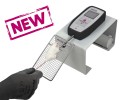Authors
M. Simard, O. Tsymbalyuk, K. Keledjian, A. Ivanov, S. Ivanova et al.
Lab
University of Maryland School of Medicine, Department of Neurosurgery, Baltimore, USA.
Journal
Experimental Neurology
Abstract
Both glibenclamide and riluzole reduce necrosis and improve outcome in rat models of spinal cord injury (SCI). In SCI, gene suppression experiments show that newly upregulated sulfonylurea receptor 1 (Sur1)-regulated NC(Ca-ATP) channels in microvascular endothelial cells are responsible for persistent sodium currents that cause capillary fragmentation and progressive hemorrhagic necrosis. Glibenclamide is a potent blocker of Sur1-regulated NC(Ca-ATP) channels (IC(50), 6-48 nM). Riluzole is a pleotropic drug that blocks persistent sodium currents in neurons, but in SCI, its molecular mechanism of action is uncertain. We hypothesized that riluzole might block the putative pore-forming subunits of Sur1-regulated NC(Ca-ATP) channels, Trpm4. In patch clamp experiments, riluzole blocked Sur1-regulated NC(Ca-ATP) channels in endothelial cells and heterologously expressed Trpm4 (IC(50), 31 _M). Using a rat model of cervical SCI associated with high mortality, we compared the effects of glibenclamide and riluzole administered beginning at 3h and continuing for 7 days after impact. During the acute phase, both drugs reduced capillary fragmentation and progressive hemorrhagic necrosis, and both prevented death. At 6 weeks, modified (unilateral) Basso, Beattie, Bresnahan locomotor scores were similar, but measures of complex function (grip strength, rearing, accelerating rotarod) and tissue sparing were significantly better with glibenclamide than with riluzole. We conclude that both drugs act similarly, glibenclamide on the regulatory subunit, and riluzole on the putative pore-forming subunit of the Sur1-regulated NC(Ca-ATP) channel. Differences in specificity, dose-limiting potency, or in spectrum of action may account for the apparent superiority of glibenclamide over riluzole in this model of severe SCI.
BIOSEB Instruments Used:
Grip strength test (BIO-GS3)

 Douleur - Allodynie/Hyperalgésie Thermique
Douleur - Allodynie/Hyperalgésie Thermique Douleur - Spontanée - Déficit de Posture
Douleur - Spontanée - Déficit de Posture Douleur - Allodynie/Hyperalgésie Mécanique
Douleur - Allodynie/Hyperalgésie Mécanique Apprentissage/Mémoire - Attention - Addiction
Apprentissage/Mémoire - Attention - Addiction Physiologie & Recherche Respiratoire
Physiologie & Recherche Respiratoire
 Douleur
Douleur Système Nerveux Central (SNC)
Système Nerveux Central (SNC)  Neurodégénérescence
Neurodégénérescence Système sensoriel
Système sensoriel Système moteur
Système moteur Troubles de l'humeur
Troubles de l'humeur Autres pathologies
Autres pathologies Système musculaire
Système musculaire Articulations
Articulations Métabolisme
Métabolisme Thématiques transversales
Thématiques transversales SFN2024: Venez rencontrer notre équipe sur le stand 876 à Chicago
SFN2024: Venez rencontrer notre équipe sur le stand 876 à Chicago 